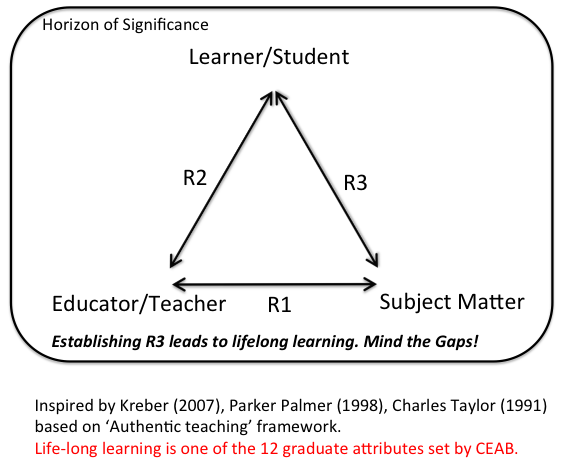January 2012: Authentic Teaching
Happy New Year!
Parker Palmer (1998) proposed a subject-centered framework in which the teachers not only convey their enthusiasm about the subject but also how and why the subject matters. Kreber (2007) and Kreber (2010) expand this further to see SoTL as an authentic teaching practice constructed around horizons of significance as discussed by Taylor (1991). One horizon of significance that Kreber (2007) mention is “…that students, while attending our institutions have a learning experience that is worthwhile and promotes their learning and development.” Subject matter then is not merely a curriculum prescription but an integral part of a teacher’s self and the values they place on their subject.
What then is authenticity in teaching? Kreber (2007) suggest “authenticity in teaching involves our caring about the subject balanced and enriched by our caring about what is in the important interest of the students.”
In a subject-centred approach to class-room, teachers seek to establish a connection between the subject matter and students. This promotes ‘authentic practice’. Grimmet and Neufeld (1994) discuss three possible motivations for teachers.
- Traditional incentives: do what is rewarded
- Alternative incentives: do what they themselves see is rewarding.
- Authentic: do what is ‘good’. Do what is necessary and of value, not just for the organisation nor just for oneself, but ultimately in the important interest of learners.
Reflecting on the above I am lead to the question: “How am I helping the students develop a relationship with the subject matter that they can continue to build beyond the course?” This is important for life long learning, one of the key attributes of graduating engineers specified by the Canadian Engineering Accreditation Boars (CEAB).
After considerable thought and reading I arrived at the following 2-D sketch to serve as a starting point for my SoTL project.
Please see my SoTL presentation Video for a more detailed explanation of the above schematic. Briefly, the teacher establishes the relationship R1 with the subject matter. Then the teacher and the students make effort to establish R2. The teacher then shows why and how the subject matters leading to R3. Once R3 is established the teacher is no longer required as the learner becomes self-directed and self-regulated in exploring other facets of the subject not taught in the classroom.The role of the teacher then is to merely serve as a guide to the landscape of learning. Once this role is fulfilled the teacher can easily be dispensed with.
It is worth noting the connection between learning principle#7 (October 2011 post) and life-long learning that can result from R3 and the metacognitive learning strategies (November 2011 post)
References
- Palmer, P., 1998, The courage to teach. Exploring the inner landscape of a teacher’s life. San Francisco: Jossey-Bass.
- Taylor, C., 1991, The ethics of authenticity. Cambridge, Mass. Harvard University Press.
- Kreber, C., 2007, What’s it really all about? The Scholarship of Teaching and Learning as an Authentic Practice, International Journal for the Scholarship of Teaching and Learning, Vol. 1, No.
- Kreber, C., McCune, V., and Klampfleitner, M., 2011, Formal and implicit conceptions of authenticity in teaching, Teaching in Higher Education, Vol. 15, No. 4, pp. 383-397.
- Grimmet, P., and Neufeld, J. (ed), 1994, Teacher development and the struggle for authenticity, Professional growth and restructuring in the context of change. Teacher College, columbia University,NU: Teachers College Press.
